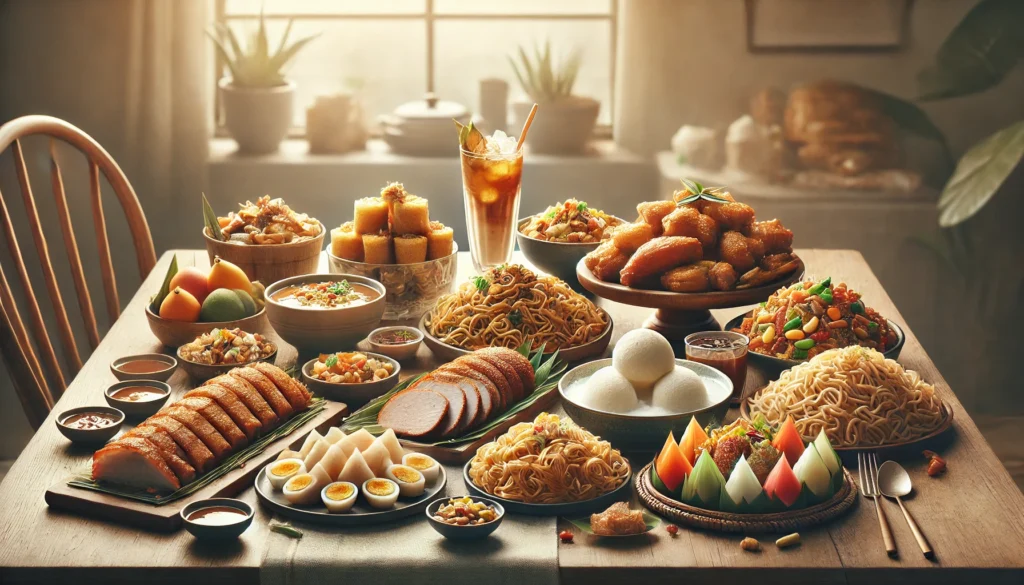Have you ever been to a Filipino party where the food seemed endless and irresistibly delicious? If so, you’ve experienced the heart of Filipino hospitality – a celebration of flavors, textures, and aromas that bring people together. Today, we’re diving into the world of Filipino party food, exploring recipes that will transform your next gathering into a feast worthy of the warmest Filipino welcome.
Filipino cuisine is a beautiful tapestry woven from indigenous, Spanish, Chinese, and American influences. This unique blend creates party dishes that are both familiar and exotic, comforting and exciting. From savory meat dishes to sweet desserts, Filipino party food offers something for everyone, often catering to various dietary needs with its diverse array of ingredients and cooking methods.
Whether you’re planning a family reunion, a birthday celebration, or simply want to bring the vibrant flavors of the Philippines to your dinner table, these recipes will guide you through creating authentic Filipino party dishes that will have your guests coming back for seconds (and thirds!).
Lumpia Shanghai: The Ultimate Filipino Party Appetizer
Ingredients
| Ingredient | Quantity |
|---|---|
| Ground pork | 1 pound |
| Carrots, finely minced | 1/2 cup |
| Onion, finely minced | 1/2 cup |
| Garlic, minced | 3 cloves |
| Egg | 1 |
| Salt | 1 teaspoon |
| Black pepper | 1/2 teaspoon |
| Soy sauce | 2 tablespoons |
| Lumpia wrappers | 1 package |
| Vegetable oil for frying | As needed |
Instructions
- Prepare the filling: In a large bowl, combine ground pork, minced carrots, onion, garlic, egg, salt, pepper, and soy sauce. Mix well until all ingredients are evenly distributed.
- Wrap the lumpia:
- Lay a lumpia wrapper on a clean, flat surface with one corner pointing towards you.
- Place about 2 tablespoons of the filling near the corner closest to you.
- Roll the wrapper tightly around the filling, folding in the sides as you go.
- Wet the top corner with water to seal the roll.
- Repeat until all the filling is used.
- Fry the lumpia:
- Heat vegetable oil in a deep pan or wok over medium heat.
- Carefully add the lumpia rolls, a few at a time, and fry until golden brown and crispy (about 3-4 minutes per side).
- Remove from oil and drain on paper towels.
- Serve: Cut each lumpia roll diagonally and serve hot with sweet chili sauce or vinegar dipping sauce.
Recipe Tips & Variations
- For a healthier version, try baking the lumpia at 375°F (190°C) for 20-25 minutes, turning halfway through.
- Vegetarian option: Replace ground pork with finely chopped mushrooms and tofu.
- Make ahead: Prepare the rolls and freeze them uncooked for up to 3 months. Fry from frozen, adding a few extra minutes to the cooking time.
Lumpia Shanghai is the quintessential Filipino party food. These crispy spring rolls are not only delicious but also perfect for feeding a crowd. The combination of savory pork filling and the satisfying crunch of the wrapper makes them irresistible to guests of all ages.
Chicken Adobo: The Heart of Filipino Cuisine
Ingredients
| Ingredient | Quantity |
|---|---|
| Chicken thighs | 2 pounds |
| Soy sauce | 1/2 cup |
| White vinegar | 1/2 cup |
| Garlic, crushed | 6 cloves |
| Bay leaves | 3 |
| Whole black peppercorns | 1 tablespoon |
| Vegetable oil | 2 tablespoons |
| Water | 1 cup |
Instructions
- Marinate the chicken:
- In a large bowl, combine soy sauce, vinegar, crushed garlic, bay leaves, and peppercorns.
- Add chicken thighs and marinate for at least 30 minutes (or overnight for best results).
- Cook the adobo:
- Heat oil in a large skillet over medium-high heat.
- Remove chicken from marinade (reserve the marinade) and brown in the skillet, about 2-3 minutes per side.
- Pour the reserved marinade and water over the chicken.
- Bring to a boil, then reduce heat and simmer, uncovered, for 20-25 minutes or until chicken is cooked through and sauce has reduced.
- Serve: Transfer chicken to a serving platter and pour the sauce over it. Serve hot with steamed rice.
Recipe Tips & Variations
- For a richer flavor, use coconut vinegar instead of white vinegar.
- Add a tablespoon of brown sugar to the sauce for a slightly sweet twist.
- Pork can be used instead of chicken for a different take on this classic dish.
Chicken Adobo is often considered the national dish of the Philippines, and for good reason. Its perfect balance of salty, tangy, and savory flavors makes it a crowd-pleaser at any Filipino gathering. The beauty of adobo lies in its simplicity – a few ingredients combine to create a dish that’s greater than the sum of its parts.
Pancit Bihon: A Symbol of Long Life and Prosperity
Ingredients
| Ingredient | Quantity |
|---|---|
| Rice noodles (bihon) | 8 ounces |
| Chicken breast, sliced | 1/2 pound |
| Shrimp, peeled and deveined | 1/2 pound |
| Carrots, julienned | 2 |
| Cabbage, shredded | 2 cups |
| Onion, sliced | 1 |
| Garlic, minced | 4 cloves |
| Soy sauce | 1/4 cup |
| Fish sauce | 2 tablespoons |
| Chicken broth | 2 cups |
| Vegetable oil | 2 tablespoons |
| Green onions, chopped | For garnish |
| Lemon wedges | For serving |
Instructions
- Prepare the noodles:
- Soak rice noodles in warm water for 15 minutes, then drain and set aside.
- Cook the protein:
- Heat oil in a wok or large skillet over medium-high heat.
- Sauté garlic and onion until fragrant.
- Add chicken and shrimp, cooking until the chicken is no longer pink and shrimp turns pink.
- Remove protein from the wok and set aside.
- Cook the vegetables:
- In the same wok, stir-fry carrots and cabbage until slightly tender.
- Combine and finish:
- Add the soaked noodles to the wok.
- Pour in soy sauce, fish sauce, and chicken broth.
- Toss everything together, cooking until the noodles are tender and have absorbed the liquid.
- Return the cooked chicken and shrimp to the wok and mix well.
- Serve: Transfer to a large serving platter, garnish with green onions, and serve with lemon wedges on the side.
Recipe Tips & Variations
- For a vegetarian version, omit the chicken and shrimp and use vegetable broth instead of chicken broth.
- Add sliced Chinese sausage (longganisa) for an extra layer of flavor.
- Experiment with different vegetables like snow peas or bell peppers for added color and nutrition.
Pancit Bihon is more than just a delicious noodle dish; it’s a symbol of long life and prosperity in Filipino culture. This makes it a staple at birthday celebrations and New Year’s feasts. The combination of thin rice noodles, tender meat, and crisp vegetables creates a harmonious blend of textures and flavors that’s sure to impress your guests.
Leche Flan: A Sweet Ending to Your Filipino Feast
Ingredients
| Ingredient | Quantity |
|---|---|
| Egg yolks | 10 |
| Condensed milk | 1 can (14 oz) |
| Evaporated milk | 1 can (12 oz) |
| Vanilla extract | 1 teaspoon |
| Sugar | 1 cup |
| Water | 1/4 cup |
Instructions
- Prepare the caramel:
- In a saucepan, combine sugar and water over medium heat.
- Stir until sugar dissolves, then let it simmer without stirring until it turns golden brown.
- Quickly pour the caramel into a 9-inch round baking pan or individual ramekins, tilting to coat the bottom evenly.
- Make the flan mixture:
- In a large bowl, whisk together egg yolks, condensed milk, evaporated milk, and vanilla extract until smooth.
- Strain the mixture to remove any lumps.
- Bake the flan:
- Pour the flan mixture over the caramel in the baking pan.
- Cover with aluminum foil.
- Place the pan in a larger baking dish filled with about an inch of hot water (bain-marie).
- Bake at 350°F (175°C) for about 60 minutes or until a knife inserted near the center comes out clean.
- Chill and serve:
- Remove from the oven and let cool to room temperature.
- Refrigerate for at least 4 hours or overnight.
- To serve, run a knife around the edges of the pan and invert onto a serving plate.
Recipe Tips & Variations
- For a richer flavor, replace some of the milk with heavy cream.
- Add a tablespoon of dayap (Filipino lime) or calamansi zest for a citrusy twist.
- Individual ramekins will cook faster, so adjust baking time accordingly.
Leche Flan is the crown jewel of Filipino desserts, gracing tables at every special occasion. Its silky smooth texture and rich caramel flavor provide the perfect sweet ending to any Filipino feast. While it may seem intimidating to make, this recipe breaks it down into simple steps that even novice cooks can master.
Conclusion
Filipino party food is a testament to the country’s rich culinary heritage and warm hospitality. From the crispy lumpia that starts the meal to the silky leche flan that ends it, each dish tells a story of family, tradition, and celebration. These recipes are more than just instructions; they’re invitations to experience the joy and community spirit that Filipino gatherings are known for.
As you prepare these dishes, remember that Filipino cooking is all about sharing and adapting. Don’t be afraid to put your own spin on these recipes or to adjust them to your taste preferences. The most important ingredient in any Filipino party food is the love and care you put into making it.
We’d love to hear about your experience cooking these Filipino party dishes! Did you try any variations? How did your guests react? Share your stories and photos with us on our social media channels or in the comments below. And don’t forget to explore our other Filipino recipes to continue your culinary journey through the Philippines.
Maraming salamat (Thank you very much) for joining us on this flavorful adventure. May your next gathering be filled with the warmth, laughter, and delicious food that make Filipino parties truly special!
Disclaimer: This blog post contains information accurate up to 2019. While we strive for accuracy, culinary trends and ingredient availability may have changed since then. Please report any inaccuracies so we can correct them promptly.




